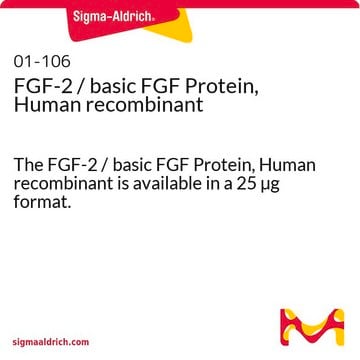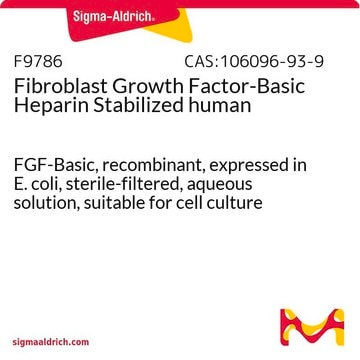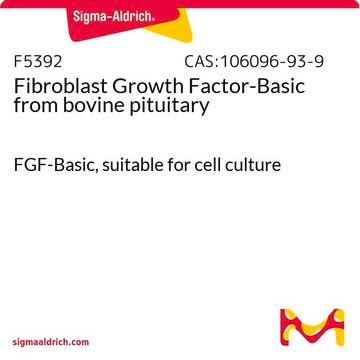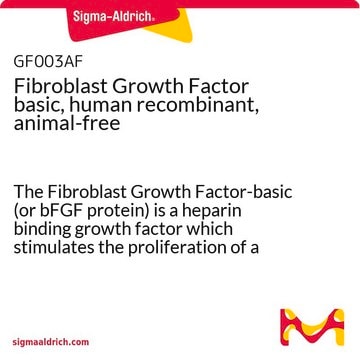SRP3043
FGF-basic human
Animal-component free, recombinant, expressed in E. coli, ≥95% (SDS-PAGE), ≥95% (HPLC), suitable for cell culture
Synonim(y):
Catabolin, Endogenous Pyrogen (EP), Leukocyte Endogenous Mediator (LEM), Lymphocyte-activating factor (LAF), Mononuclear Cell Factor (MCF)
Wybierz wielkość
1810,00 zł
Wybierz wielkość
About This Item
1810,00 zł
Polecane produkty
pochodzenie biologiczne
human
rekombinowane
expressed in E. coli
Próba
≥95% (HPLC)
≥95% (SDS-PAGE)
Formularz
lyophilized
siła działania
≥1x10^7 units/mg
masa cząsteczkowa
17.2 kDa
opakowanie
pkg of 50 μg
metody
cell culture | mammalian: suitable
zanieczyszczenia
<0.1 EU/μg endotoxin, tested
kolor
white to off-white
numer dostępu UniProt
Warunki transportu
wet ice
temp. przechowywania
−20°C
informacje o genach
human ... FGF2(2247)
Opis ogólny
Zastosowanie
Działania biochem./fizjol.
Sekwencja
Postać fizyczna
Rekonstytucja
Kod klasy składowania
11 - Combustible Solids
Klasa zagrożenia wodnego (WGK)
WGK 3
Temperatura zapłonu (°F)
Not applicable
Temperatura zapłonu (°C)
Not applicable
Wybierz jedną z najnowszych wersji:
Certyfikaty analizy (CoA)
Nie widzisz odpowiedniej wersji?
Jeśli potrzebujesz konkretnej wersji, możesz wyszukać konkretny certyfikat według numeru partii lub serii.
Masz już ten produkt?
Dokumenty związane z niedawno zakupionymi produktami zostały zamieszczone w Bibliotece dokumentów.
Klienci oglądali również te produkty
Produkty
Discover answers to your frequently asked questions about animal component-free, xenobiotic-free, and chemically defined media and reagents for cell culture.
Fibroblast growth factors in cell culture and various growth factors for your research
Czynniki wzrostu fibroblastów w hodowli komórkowej i różne czynniki wzrostu na potrzeby badań
Active Filters
Nasz zespół naukowców ma doświadczenie we wszystkich obszarach badań, w tym w naukach przyrodniczych, materiałoznawstwie, syntezie chemicznej, chromatografii, analityce i wielu innych dziedzinach.
Skontaktuj się z zespołem ds. pomocy technicznej









